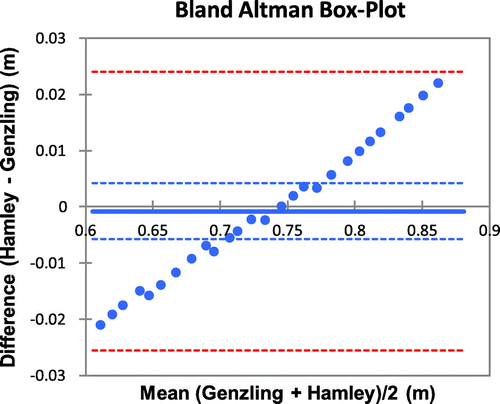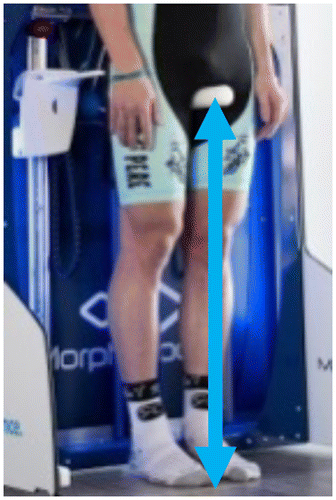Keywords:
1. Introduction
The optimization of the cyclist’s position aims to increase performance and may prevent overuse injuries. To find the optimum posture, taking into account anthropometry of the cyclist is essential. Thereby, a properly saddle height, adapted at the cyclist morphology, is primordial: it allows to increase performance (Hamley and Thomas, Citation1967) and to improve the pedalling biomechanics (articular kinematics and muscular activity; De Vey Mestdagh Citation1998). Several authors have studied this parameter to find the optimal saddle height as static method based on the inseam length (Hamley and Thomas Citation1967; Genzling Citation1980) or static method based on the knee angle during goniometric assessment with the pedal located at the bottom dead center (Holmes et al. Citation1994). However, it appears a substantial discrepancy between all these methods (Peveler et al., Citation2007).
The aim of this preliminary study is to compare two statics methods based on the inseam length which are frequently used in the literature: Genzling method (Citation1980) and Hamley method (Citation1967).
2. Methods
Twenty-seven male recreational cyclists, with different morphology, were recruited. The inseam length of the participants, measured with the Morphologics Company device (ML Size, Morphologics, Saint-Malo, France), was 0.831 m ± 0.079 m (mean ± standard deviation).
The optimal saddle height was calculated, using this parameter, for each method.
| • | Genzling method: 0.885 × Inseam length | ||||
| • | Hamley method: 1.09 × Inseam length – crank arm length | ||||
To identify the optimal crank arm length, we also leaned on the inseam length, following the recommendations of De Vey Mestdagh (Citation1998). The limited variety of crank arm length, available in retail cycle sales, is between a minimum of 0.165 m and a maximum of 0.180 m in steps of 0.0025 m.
Then, a three-step statistical analysis was made, to observe the differences of saddle height with the two methods.
First, a descriptive analysis allowed comparing the saddle height with the two methods in order to observe the trend.
Secondly, a correlation test measured the intensity of the linear relation between both methods.
Thirdly, a Bland Altman analysis was used to perform the discrepancy between the Genzling method and the Hamley method.
3. Results and discussion
The results of the descriptive analysis are presented in the Table .
Table 1. Descriptive analysis of the Genzling method and the Hamley method.
The mean of saddle height is nearly identical (±0.001 m). However, the standard deviation is different (0.07 and 0.083 m for the Genzling method and the Hamley method respectively), causing a substantial discrepancy in the extreme values: the minimum value is 0.621 m with the Genzling method and 0.6 m with the Hamley method and the maximum value is 0.85 m with the Genzling method and 0.872 m with the Hamley method, showing the large difference for the persons with the shortest and longest inseam length (>0.002 m).
The Pearson test shows a determination coefficient r2 of 0.99 (p < 0.01), reflecting the strong linear relation between the two methods.
The Bland Altman test allowed comparing the discrepancies between the Genzling method and the Hamley method (Figure ).
Figure 2. Bland Altman box plot illustrating the difference between the Genzling method and the Hamley method.

The Bland Altman analysis starts with an analysis of the bias which is – 0.00076 m ± 0.013 m. The bias is near zero because the average of saddle height with the two methods is approximately similar (±0.001 m). This difference seems to be insignificant because the saddle height is dependant of the inseam length measurement error and the adjustment of the saddle with a tape measure. The lower 95% limit is – 0.026 m and the upper 95% limit is 0.024 m. The limits of agreement show the substantial discrepancy in the extreme values. Therefore, the correlation is strong but the discrepancy equally.
We can observe that the uses of these coefficients to find the optimal saddle height doesn’t cause differences for medium-sized persons with an inseam length between 0.80 and 0.85 m, but a derivative appears and increases when we approach of the extreme values (short or long inseam height).
This observation allows interpreting the results of Peveler et al. (Citation2007) who observed that only 63% of the cyclists in a population of 27 subjects have a suitable knee angle, in the range of 25° and 35° (Holmes et al. Citation1994), when they used the Hamley method. Unfortunately, they did not specify the inseam length of the subjects. For Ferrer-Roca et al. (Citation2014), small changes in saddle height (2%) affects significantly the gross efficiency and the lower limb kinematics, demonstrating the real impact of using one or the other method on health and performance for people of large and small size.
These observations suggest that a single coefficient to find the optimal saddle height isn’t adapted. It’s essential to take into account the morphology of the cyclists (± long inseam length) and to nuance the coefficient in terms of this parameter.
4. Conclusions
This preliminary study aims to compare two methods allowing a postural adjustment of the saddle height in cycling, using the inseam length.
The important differences of results in the extreme values demonstrate a substantial discrepancy between the two methods. These differences might cause a decrease of performance (Ferrer-Roca et al. Citation2014) and an increase of overuse injuries (De Vey Mestdagh Citation1998). Furthers researches are necessary to find a new method which take into account the proportion related to the anthropometry of the cyclist, and particularly of the children with a short inseam length who have been subject of little research in the literature.
Acknowledgements
The authors thank the Morphologics Company and particularly Michel Le Goallec and William Le Goallec for their implication in this study.
References
- De Vey Mestdagh K. 1998. Personal perspective: in search of an optimum cycling posture. Appl Ergonom. 29(5):325–334.10.1016/S0003-6870(97)00080-X
- Ferrer-Roca V, Bescós R, Roig A, Galilea P, Valero O, García-López J. 2014. Acute effects of small changes in bicycle saddle height on gross efficiency and lower limb kinematics. J Strength Conditioning Res. 28(3):784–791.10.1519/JSC.0b013e3182a1f1a9
- Genzling C. 1980. Le dossier de la position, Géométrie d’une pléiade. Le Cycle. 53:32–36.
- Hamley EY, Thomas V. 1967. Physiological and postural factors in the calibration of the bicycle ergometer. J Physiol. 191(2):55–56.
- Holmes JC, Pruitt AL, Whalen NJ. 1994. Lower extremity overuse in bicycling. Clinics Sports Med. 13(1):187–205.
- Peveler WW, Pounders JD, Bishop PA. 2007. Effects of saddle height on anaerobic power production in cycling. J Strength Cond Res. 21(4):1023–1027.

